Seat Leon 5D 2007 Owner's manual
Manufacturer: SEAT, Model Year: 2007, Model line: Leon 5D, Model: Seat Leon 5D 2007Pages: 302, PDF Size: 9.14 MB
Page 251 of 302

If and when249
Safety First
Operating instructions
Tips and Maintenance
Te c h n i c a l D a t a
Main beam lights–Raise the bonnet
– Remove the cover ⇒fig. 166 by pulling on this. – Remove the connector
⇒fig. 167 from the bulb.
– Press the spring ⇒fig. 167 inwards and to the right.
– Extract the bulb and fit the replacement so that it sits correctly into the cut-out on the reflector.
– Installation is done in the reverse order.
Fig. 166 Main beam
headlightsFig. 167 Main beam
headlights
AC
A1
A2
leon ingles.book Seite 249 Dienst ag, 11. September 2007 1:47 13
Page 252 of 302
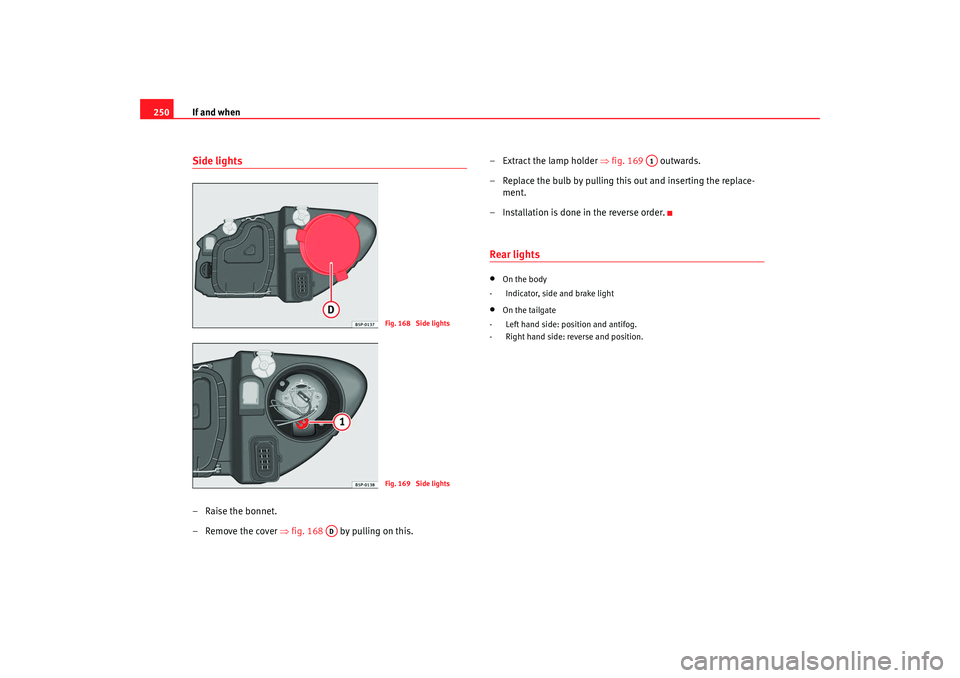
If and when
250Side lights– Raise the bonnet.
– Remove the cover ⇒fig. 168 by pulling on this. – Extract the lamp holder
⇒fig. 169 outwards.
– Replace the bulb by pulling this out and inserting the replace- ment.
– Installation is done in the reverse order.
Rear lights•
On the body
- Indicator, side and brake light
•
On the tailgate
- Left hand side: position and antifog.
- Right hand side: reverse and position.
Fig. 168 Side lightsFig. 169 Side lights
AD
A1
leon ingles.book Seite 250 Dienst ag, 11. September 2007 1:47 13
Page 253 of 302
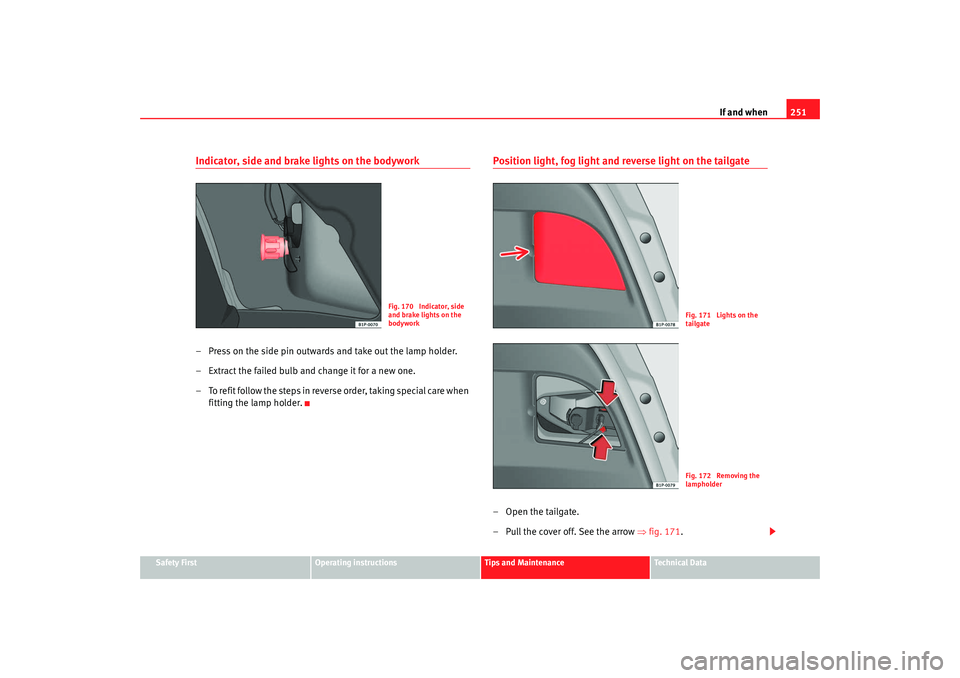
If and when251
Safety First
Operating instructions
Tips and Maintenance
Te c h n i c a l D a t a
Indicator, side and brake lights on the bodywork– Press on the side pin outwards and take out the lamp holder.
– Extract the failed bulb and change it for a new one.
– To refit follow the steps in reverse order, taking special care when
fitting the lamp holder.
Position light, fog light and reverse light on the tailgate–Open the tailgate.
– Pull the cover off. See the arrow ⇒ fig. 171.
Fig. 170 Indicator, side
and brake lights on the
bodywork
Fig. 171 Lights on the
tailgateFig. 172 Removing the
lampholder
leon ingles.book Seite 251 Dienstag, 11. September 2007 1:47 13
Page 254 of 302

If and when
252
– Take the lampholder out pressing on the securing pins and extract it outwards ⇒page 251, fig. 172 .
– Replace the faulty lamp, rotating it to the left and outwards.
– Installation is done in the reverse order.Side indicators– Press the indicator on one of its sides to take it out.
– Remove the lamp holder from the indicator.
– Remove the failed glass bulb and replace with a new bulb.
– Insert the lamp holder in the indicator guide until it clicks into place. – First place the indicator in the opening in the bodywork, fixing
the tabs ⇒fig. 173 , arrow .
– Insert the lamp as shown by the arrow ⇒fig. 173.
Fig. 173 Side indicator
A1
A2
leon ingles.book Seite 252 Dienst ag, 11. September 2007 1:47 13
Page 255 of 302
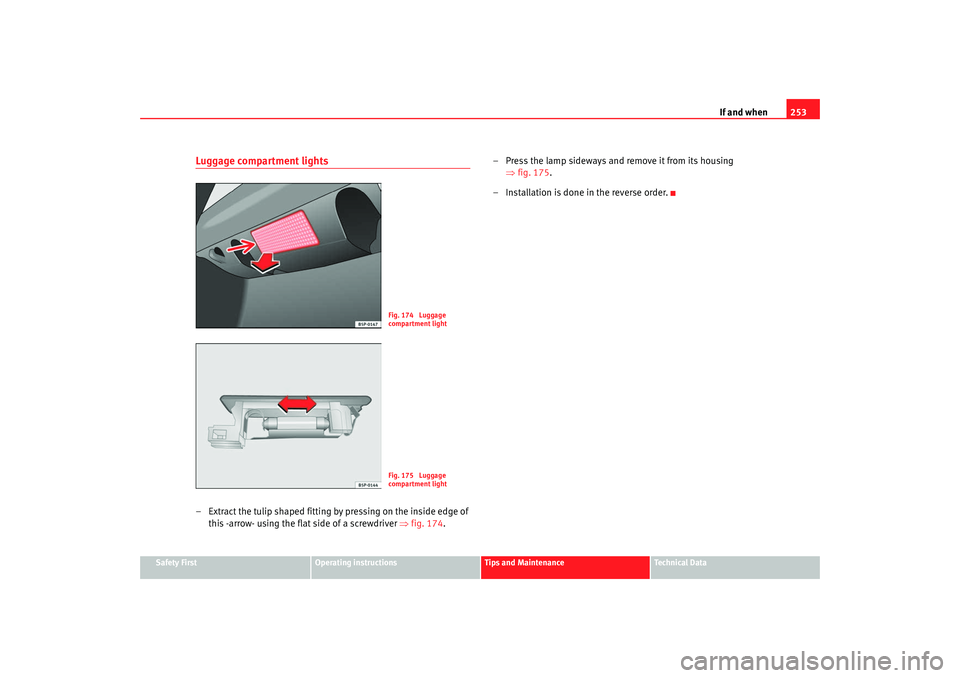
If and when253
Safety First
Operating instructions
Tips and Maintenance
Te c h n i c a l D a t a
Luggage compartment lights– Extract the tulip shaped fitting by pressing on the inside edge of
this -arrow- using the flat side of a screwdriver ⇒fig. 174. – Press the lamp sideways and remove it from its housing
⇒fig. 175.
– Installation is done in the reverse order.
Fig. 174 Luggage
compartment lightFig. 175 Luggage
compartment light
leon ingles.book Seite 253 Dienst ag, 11. September 2007 1:47 13
Page 256 of 302
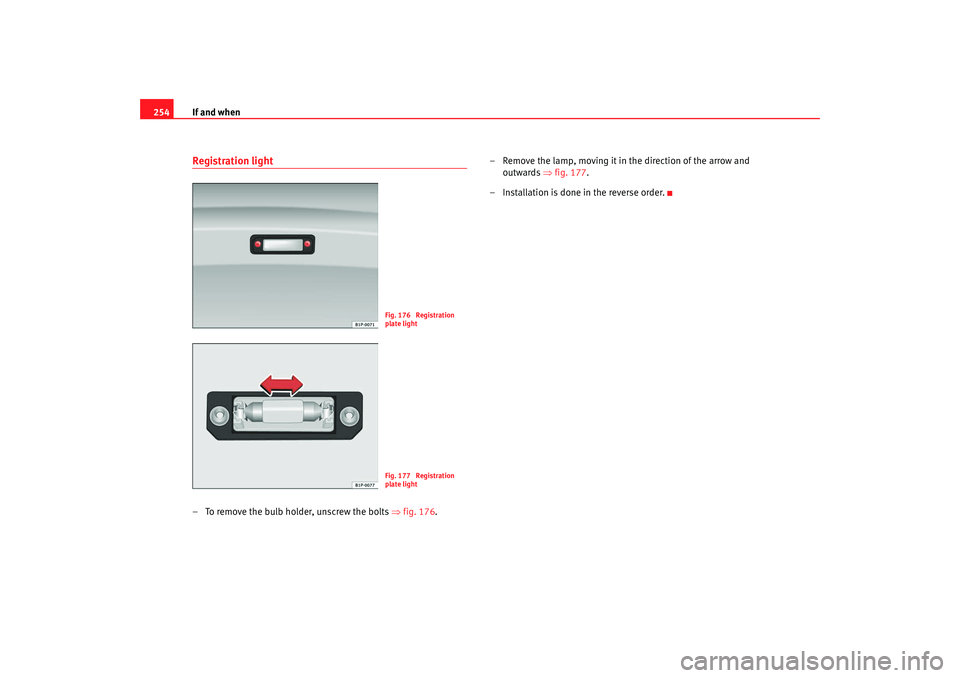
If and when
254Registration light– To remove the bulb holder, unscrew the bolts ⇒fig. 176. – Remove the lamp, moving it in the direction of the arrow and
outwards ⇒fig. 177 .
– Installation is done in the reverse order.
Fig. 176 Registration
plate lightFig. 177 Registration
plate light
leon ingles.book Seite 254 Dienst ag, 11. September 2007 1:47 13
Page 257 of 302

If and when255
Safety First
Operating instructions
Tips and Maintenance
Te c h n i c a l D a t a
Sunroof light– Carefully remove the lamp, using the flat side of the screwdriver,
as shown in the figure ⇒fig. 179. – Remove the lamp, moving it in the direction of the arrow and
outwards ⇒fig. 179.
– Installation is done in the reverse order.
Jump-startingJump leads
The jump lead must have a sufficient wire cross section.If the engine fails to start because of a discharged battery, the battery can be
connected to the battery of another vehicle to start the engine.
Jump leads
Jump leads must comply with the standard DIN 72553 (see manufacturer's
documentation). The wire cross section must be at least 25 mm
2 for petrol
engines and at least 35 mm
2 for diesel engines.
Note
•
The vehicles must not touch each othe r, otherwise electricity could flow as
soon as the positive terminals are connected.
•
The discharged battery must be properly connected to the vehicles elec-
trical system.
Fig. 178 Removing
sunroof lightFig. 179 Removing
sunroof light
leon ingles.book Seite 255 Dienst ag, 11. September 2007 1:47 13
Page 258 of 302

If and when
256How to jump start: descriptionIn ⇒ fig. 180, the flat battery is and the charged battery .
Jump lead terminal connections
– Switch off the ignition on both vehicles ⇒.
1. Connect one end of the red jump lead to the positive ⇒fig. 180
terminal of the vehicle with the flat battery ⇒.
2. Connect the other end of the red jump lead to the positive terminal in the vehicle providing assistance.
3. Connect one end of the black jump lead to the negative terminal on the battery of the vehicle providing assistance. 4. Connect the other end of the black jump lead to a solid metal
component which is bolted on to the engine block, or onto the
engine block itself of the vehicle with the flat battery. Do not
connect it to a point near the battery ⇒.
5. Position the leads in such a way that they cannot come into contact with any moving parts in the engine compartment.
Starting
6. Start the engine of the vehicle with the boosting battery and let it run at idling speed.
7. Start the engine of the car with the flat battery and wait one or two minutes until the engine is “running”.
Removing the jump leads
8. Before you remove the jump leads, switch off the headlights (if they are switched on).
9. Turn on the heater blower and rear window heater in the vehicle with the flat battery. This helps minimise voltage peaks which are
generated when the leads are disconnected.
10. When the engine is running, disconnect the leads in reverse order to the deta ils given above.
Connect the battery clamps so they have good metal-to-metal contact with
the battery terminals.
If the engine fails to start, switch off the starter after about 10 seconds and
try again after about half a minute.
Fig. 180 How to connect
the jump leads
AA
AB
A+
A+
A-
AX
leon ingles.book Seite 256 Dienst ag, 11. September 2007 1:47 13
Page 259 of 302
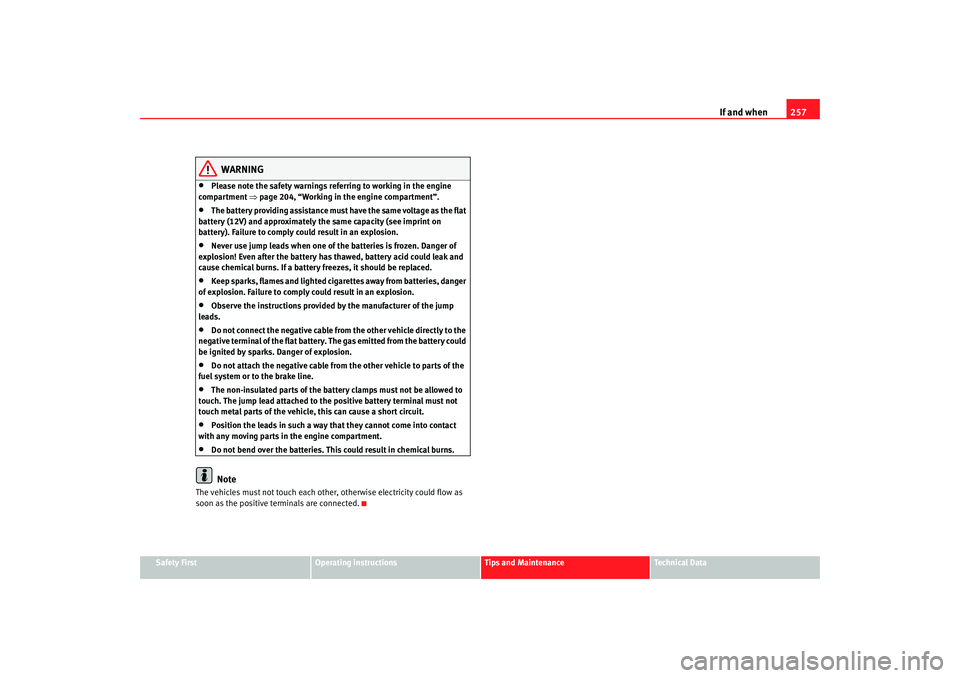
If and when257
Safety First
Operating instructions
Tips and Maintenance
Te c h n i c a l D a t a
WARNING
•
Please note the safety warnings referring to working in the engine
compartment ⇒page 204, “Working in the engine compartment”.
•
The battery providing assistance must have the same voltage as the flat
battery (12V) and approximately the same capacity (see imprint on
battery). Failure to comply could result in an explosion.
•
Never use jump leads when one of the batteries is frozen. Danger of
explosion! Even after the battery has thawed, battery acid could leak and
cause chemical burns. If a battery freezes, it should be replaced.
•
Keep sparks, flames and lighted cigarettes away from batteries, danger
of explosion. Failure to comply could result in an explosion.
•
Observe the instructions provided by the manufacturer of the jump
leads.
•
Do not connect the negative cable from the other vehicle directly to the
negative terminal of the flat battery. The gas emitted from the battery could
be ignited by sparks. Danger of explosion.
•
Do not attach the negative cable from the other vehicle to parts of the
fuel system or to the brake line.
•
The non-insulated parts of the battery clamps must not be allowed to
touch. The jump lead attached to the positive battery terminal must not
touch metal parts of the vehicle, this can cause a short circuit.
•
Position the leads in such a way that they cannot come into contact
with any moving parts in the engine compartment.
•
Do not bend over the batteries. This could result in chemical burns.Note
The vehicles must not touch each other, otherwise electricity could flow as
soon as the positive terminals are connected.
leon ingles.book Seite 257 Dienst ag, 11. September 2007 1:47 13
Page 260 of 302

If and when
258To w i n g a n d t o w - s t a r t i n gTo w - s t a r t i n g
The use of jump leads is preferable to tow-starting.We recommend that you do not t o w - s t a r t yo u r v e h i c l e . J u m p - s ta r t i n g
is preferable ⇒page 255.
However, if your vehicle has to be tow-started:
– Engage the 2
nd or the 3
rd gear.
– Keep the clutch pressed down.
– Switch on the ignition.
– Once both vehicles are moving, release the clutch.
– As soon as the engine starts, press the clutch and move the gear lever into neutral. This helps to prevent driving into the towing
vehicle.
WARNING
The risk of accidents is high when tow-starting. The vehicle being towed
can easily collide with the towing vehicle.
Caution
When tow-starting, fuel could enter the catalytic converter and damage it.
CommentsPlease observe the following points if you use a tow-rope:
Notes for the driver of the towing vehicle
– Drive slowly at first until the tow-rope is taut. Then accelerate gradually.
– Begin and change gears cautiously. If you are driving an auto- matic vehicle, accelerate gently.
– Remember that the brake servo and power steering are not working in the vehicle you are towing. Brake earlier than you
would normally, but with a more gentle pressure on the brake.
Notes for the driver of the towed vehicle
– Ensure that the tow-rope remains taut at all times when towing.Tow-rope or tow-bar
It is easier and safer to tow a vehicle with a tow-bar. You should only use a
tow-rope if you do not have a tow-bar.
A tow-rope should be slightly elastic to reduce the loading on both vehicles.
It is advisable to use a tow-rope made of synthetic fibre or similarly elastic
material.
Attach the tow-rope or the tow-bar only to the towing eyes provided or a
towing bracket.
Driving style
Towing requires some experience, espec ially when using a tow-rope. Both
drivers should be familiar with the te chnique required for towing. Inexperi-
enced drivers should not attempt to tow-start or tow away another vehicle.
leon ingles.book Seite 258 Dienst ag, 11. September 2007 1:47 13